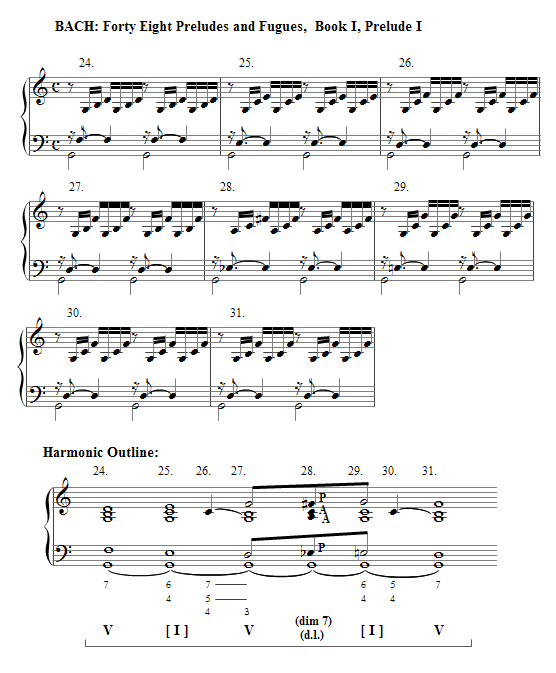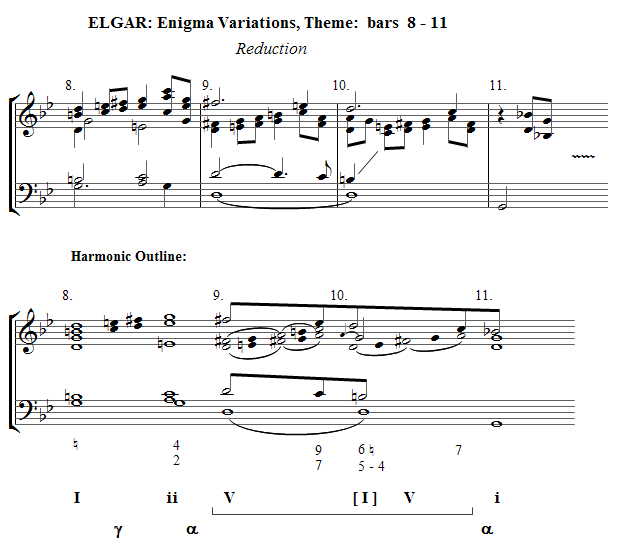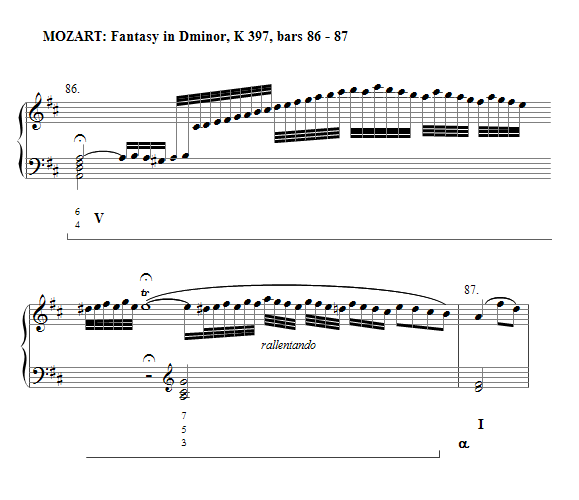
CHAPTER 5 (PART 2)
EXTENSIONS WITHIN THE BASIC STRUCTURE
The Dominant Prolongation
The dominant prolongation is the most common type of internal extension to the basic syntactic structure. Here, the dominant chord of the cadence is prolonged by the use of static harmony in a similar way to the way the tonic chord is prolonged in the opening section of the musical phrase. All the techniques explained in the previous chapters for prolonging the tonic can be applied to the dominant chord. These are:
- Combinations of voice leading elaborations.
- Static harmony deploying auxiliary chords that fill in between dominant chords
- The use of a dominant pedal note underscoring the static harmony.
- The use of passing chords filling in between the dominant and auxiliary chords.
- The use of linear progressions filling in between the dominant and auxiliary chords or successive dominants.
In addition the dominant cadential harmony may be extended in two ways not usually deployed in opening section static harmony:
- The cadential 6 4 (see Chapter 3 (part 4)) with or without further elaboration.
- Cadenzas which are long melodic elaborations used at the ends of some movements
Dominant prolongations are very common and are used in some form or other in most pieces of music. They vary from short elaborations just deploying a cadential 6 4 chord to long prolongations and cadenzas that extend over many bars. The more structurally important the position in the music, the longer and more elaborate the dominant prolongation may be. Dominant chords involved in the dominant prolongations often contain added 7ths and sometimes added 9ths. Even short cadential dominant chords normally contain some kind of elaboration such as a cadential 6 4 elaboration or a suspension to highlight the fact that it is the dominant chord of the cadence.
Dominant prolongations are prolongations of the cadential dominant chord and form a syntactic function in the phrase. Non-cadential dominant chords are not normally prolonged in this way.
The following figure shows the form of a complete phrase extended by a dominant prolongation:
a) The dominant Prolongation
When considering the structure of the musical phrase (static harmony, dynamic harmony, cadence) bear in mind that it is important to distinguish between tonic static harmony and dominant static harmony. The first starts off the phrase and establishes the key. The dominant static harmony, if it exists in the phrase, is part of the cadence and delays the end of the phrase and so each is anchored in the phrase in different positions in relation to the cadence. Dominant prolongations can be distinguished from tonic prolongations by a combination of context (position in relation to the cadence) and the fact that dominant prolongations are likely to have 7ths in the main structural chords (i.e. dominant 7th chords) whereas in tonic prolongations, the 7ths (if present) are more likely to be on the auxiliary chords. (However, sometimes the tonic takes on a minor 7th when moving to an auxiliary chord IV. See also section on the blues).
The following eight bar dominant prolongation from the Bach: First Prelude (see below) is based on a simple oscillation between dominant and tonic. The dominant and tonic chords here exchange roles in comparison with their roles in an opening section static harmony. That is to say, in this dominant prolongation the tonic chord acts as an auxiliary chord to the repeated occurrences of the dominant chord which is being prolonged. The tonic auxiliary chords are shown in square brackets in the harmonic outline.
At bar 27 to 29 the movement from chord V to auxiliary chord I is further elaborated by chromatic passing notes in parallel 10ths. (D moves to E-flat and then E-natural in the tenor voice and F moves to F# and then G in the soprano voice). The chromatic passing notes, along with two auxiliary notes, result in a dominant leading diminished 7th chord in bar 28. At bars 26 and 30 the harmony is further elaborated by suspensions. These suspensions are shown as black notes with stems in the harmonic outline. The whole prolongation is underscored and delimited by a dominant pedal.

The dominant prolongation shown above is preceded by 23 bars of dynamic harmony and followed by a 4 bar static coda (see later). This means that the whole prelude is syntactically in the form of a closing section only.
The following example from Elgar: Enigma Variations shows a dominant prolongation in context. It is preceded by I - II - dynamic harmony and followed by the tonic chord. As in the previous example, the dominant prolongation uses chord I as the auxiliary chord and the prolongation is underpinned by a dominant pedal. As can be seen from the harmonic outline, the dominant is prolonged by a combination of:
- an auxiliary chord I in bar 10, in second inversion (auxiliary 6 4)
- arpeggiation of the dominant chord along with passing notes in bars 9 and 10, shown by slurs and black note heads
- a passing 7th, in the tenor voice in bar 9 and in the top voice in bar 10, each highlighted with stems and beams.
- a passing 9th in the last beat of bar 9, in parallel 10ths with the 7th in the tenor.
These are shown in the harmonic outline. The horizontal square bracket indicates the extent of the dominant prolongation.

The dominant cadential harmony may be extended in two ways not usually deployed in opening section static harmony. These are the cadential 6 4 appoggiatura chord (discussed in chapter 3 (part 4)) and the cadenza. The cadenza can be anything from a simple short elaboration of the dominant chord to many bars of improvisational music. When these are used in combination, the elaboration starts during the 6 4 harmony and continues into the dominant harmony. Whatever the nature and length of the cadenza, the function is to prolong the dominant cadential harmony, thus delaying the completion of the cadence whilst at the same time highlighting the end of the phrase, section or movement. The following example illustrates a brief cadenza that elaborates the underlying cadential 6 4 and dominant harmony:

See Demo 4 for an animated example of a phrase containing a dominant prolongation.


